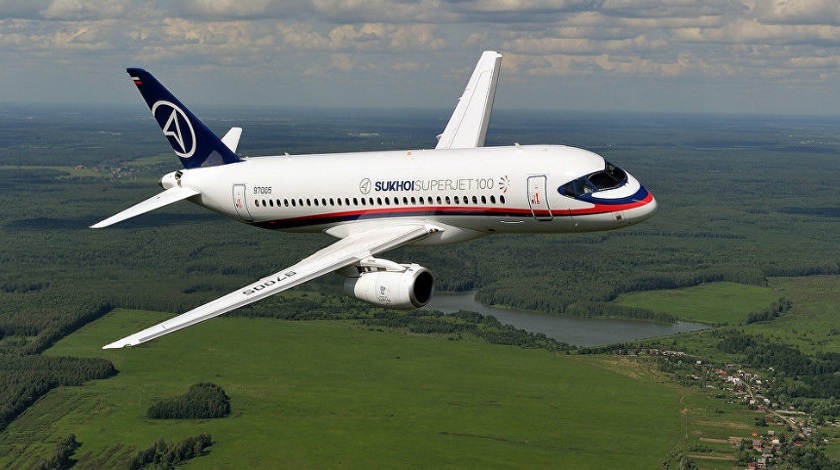Photo: Wikimedia
Reading Time: 3 minutesRussian aircraft manufacturer Sukhoi Civil Aircraft Co, part of the state-owned United Aircraft Corporation, is working on a cargo version of its Sukhoi Superjet regional aircraft. The freighter version scheme is listed in SCAC’s latest annual report as a priority project in the further development of the SSJ100 programme.
Although the document provides no further specific details of the freighter project, there are a number of other developments on the list, including a shortened version of the passenger aircraft, scaled down from 100 to 76-88 seats, offering a flight range of between 1,500 and 2,500 km. The programme schedule sets the service entry for this iteration at between 2022 and 2023.
Another priority announced by SCAC earlier this year is the desire by the original equipment manufacturer to significantly increase the proportion of Russian-made components in the version dubbed SSJ100R. This Russianised edition is being designed specifically for Russian governmental customers and for those export markets which are under restrictions imposed by the USA.
Finally, a new twist in the project of the stretched version of the aircraft has been revealed. In the latest iteration it has mutated into ‘an added-capacity’ version of the base 100-seater. Last year the manufacturer announced it was planning to launch a 130-seat platform, with the simultaneous introduction of a new wing at some point within the 2023 timeframe.
However, the latest insider information, from sources close to the airframe manufacturer’s parent UAC, points to a different idea, namely the fitting of more seats into the existing fuselage originally designed to seat a maximum of 103 passengers.
Nevertheless, both the added-capacity project and the cargo version are at an concept design stage and all of the new proposed modifications will target “the actual needs of potential customers,” SCAC insists.
At the same time, a number of upgrades are underway for the existing basic version of the aircraft, including the expansion of its operational capabilities, such as for its performance in hot-and-high conditions, to +50C and 4,000 m ASL. Work on an improvement of the company’s after-sales support is also underway.
The manufacturer is meanwhile also continuing to work on improving the Sukhoi Business Jet, including extending its range to 7,000 km by installing auxiliary fuel tanks. Several specific milestones are set for this year, such as achieving certification of ‘saberlet’ winglets for improved aerodynamic efficiency, and for approval of steep glide-slope approaches needed for smaller runway airports such as those like London’s City Airport operations as envisioned by SSJ’s Irish customer CityJet.
Throughout all of this development work, the Russian government has announced it will support the SSJ100 family project – by allocating six billion rubles from the state reserve fund in 2018.
Last year a total of 34 SSJ100s were produced, with plans for 30 deliveries in 2018, but not all production slots are contracted yet, the document shows. The delivery target for the next five years encompasses between 170 and 180 aircraft, including the SBJ version. Overall sales projections for the 2018 to 2030 timeframe are 345 units, with the majority expected to stem from operators within Russia and the wider CIS, as well as in south-east Asia and Latin America.
SCAC claims it is currently in negotiations with several potential customers in Europe, Asia, Africa and Latin America, and the aim of achieving Chinese validation for the aircraft is well underway, with 90 per cent of the Chinese authorities’ requirements already satisfied, the company says.
At the same time, the process of winning approval from European aviation authorities remains complicated, due to the absence of bilateral agreements between Rosaviatsiya (the Russian regulator, which recently took over the certification responsibility from CIS’ Interstate Aviation Committee’s Aviaregister) and international aviation authorities in terms of accepting each other’s certification standards.
As of now, with Rosaviatsiya unable to provide a one-stop-shop representation to deal solely with EASA, the manufacturer is therefore continuing a parallel certification effort by involving not only Rosaviatsiya, but also the Interstate Aviation Committee. The aim is to reach agreement with EASA to facilitate the seamless operation and continued airworthiness of the fleet operated in international markets.
Financial results for last year indicate that SCAC’s net losses decreased three-fold to 1.101 billion rubles (some US$19 million) in 2017. Yields grew 18.4 per cent to 55,368 billion rubles. In an interview with Russian state newswire TASS, SCAC president Alexander Rubtsov stated that the break-even point is not expected before 2019 or 2020, assuming a required production rate of 32 to 34 aircraft per year.

